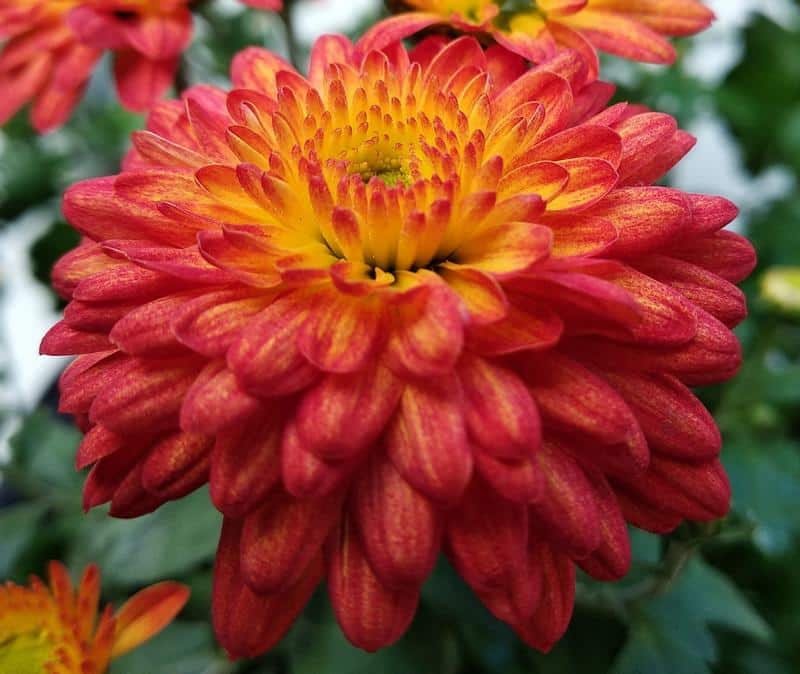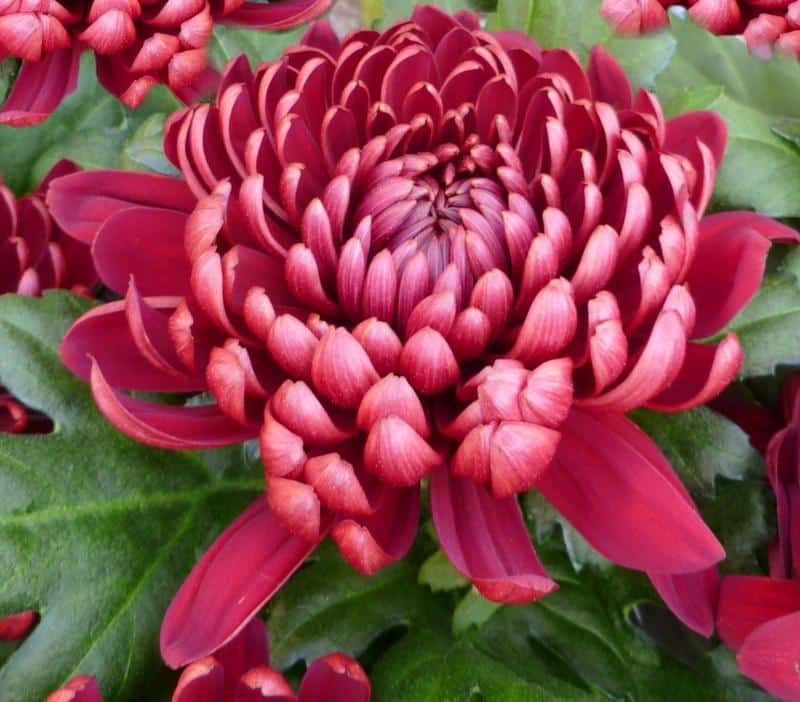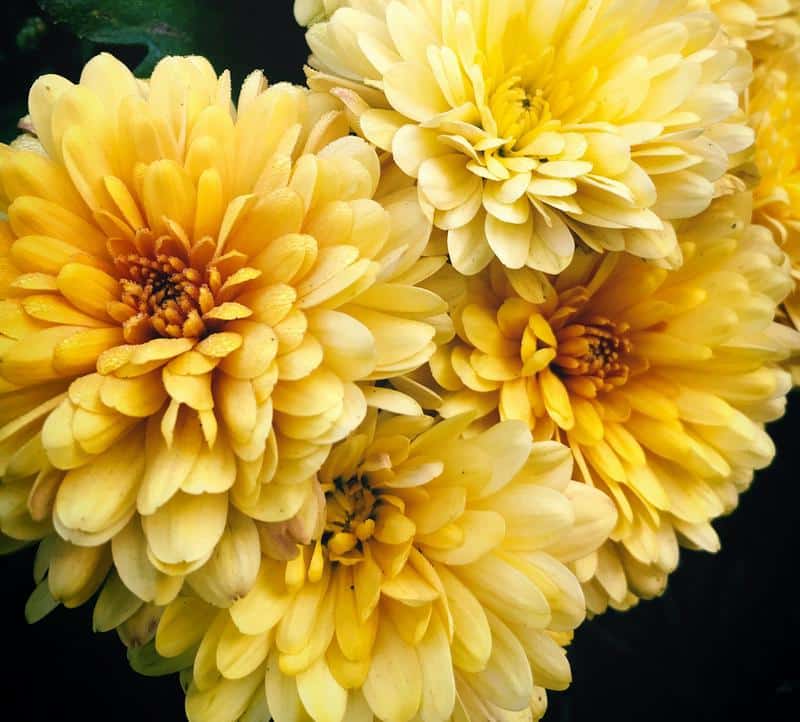Are Chrysanthemums Poisonous to Dogs? Are Chrysanthemums Toxic to Dogs?
Are Chrysanthemums poisonous to dogs? Are Chrysanthemums toxic to dogs? In this article, we’ll go over everything you need to know about if Chrysanthemums are safe for dogs including what to do if your dog ate Chrysanthemums already. We’ll then explain the two commands that will ensure your dog behaves around Chrysanthemums and other potentially poisonous plants.
Next, we’ll teach you more you should know about Chrysanthemums and dogs, such as how to keep dogs away from Chrysanthemums using barriers and other methods. Finally, we’ll instruct you on Chrysanthemum care (outdoor care, symbolism, uses and benefits, growing in pots, sun or shade, zone, light and water requirements) and more to know when you have dogs. Keep reading!
Are Chrysanthemums Poisonous to Dogs?

Chrysanthemums are poisonous to dogs. They contain compounds known as pyrethrins, which can be toxic to dogs if ingested. While Chrysanthemums are a common sight in gardens and floral arrangements, you should exercise caution, as exposure to these flowers can cause adverse reactions for your dog.
Are Chrysanthemums Toxic to Dogs?
Chrysanthemums are toxic to dogs due to the presence of pyrethrins, natural compounds that act as insecticides. While not lethal in small quantities, ingestion of these flowers can lead to symptoms like vomiting, diarrhea, hypersalivation, and incoordination in dogs. Prompt veterinary care is essential if ingestion occurs.
Chrysanthemum Poisoning in Dogs Symptoms
Symptoms of Chrysanthemum poisoning in dogs may vary depending on the amount ingested. Common signs include:
- Vomiting
- Diarrhea
- Drooling
- Incoordination
- Dermatitis (if exposed to skin)
Monitoring for these symptoms and seeking immediate veterinary care can mitigate the risks and aid in a quick recovery.
Train “Leave It” Command
Training the “Leave It” command can be incredibly valuable, especially in preventing unwanted interactions with Chrysanthemums or other toxic substances. The step-by-step process involves:
- Start with a treat in your closed fist and present it to the dog without letting it have it.
- When the dog tries to get it and then pulls away, say “Leave it” and reward the dog with a different treat.
- Gradually increase the difficulty by placing the treat on the ground and covering it with your hand, still rewarding the dog when it pulls away.
- Continue practicing the command with various distractions and in different environments.
- Always reinforce positive behavior with verbal praise and rewards.
This command not only helps keep your dog away from Chrysanthemums but also improves general obedience and can be used in various situations.
Train “Drop It” Command
The “Drop It” command is equally essential, and the training process involves several stages:
- Start with a toy in the dog’s mouth and present a treat, saying “Drop It.”
- When the dog drops the toy to take the treat, provide positive reinforcement.
- Repeat the process with different objects, slowly removing the treat reward and replacing it with praise.
- Regularly practice the command with various objects to ensure a consistent response.
- Incorporate the command into playtime, making it a fun and rewarding experience.
Training this command can be a lifesaver if your dog picks up a Chrysanthemum or any other potentially harmful object, as it gives you one last chance to get them to drop it.
But while these commands will keep your dog safe around Chrysanthemums, it’s important to remember that the underlying behavioral issues (curiosity, anxiety, boredom, etc.) that were causing all of this to begin with will still be present. And until you address those, any positive changes you see are only going to be temporary.
“Well, how do I make these changes last?”
By getting your dog to truly choose to follow your direction, that’s how. I tried many times to write out how you can do that before deciding it made more sense to just link you to the free video series that explains it better than I’d ever be able to.
The series is by a man named Dan who is one of the world’s leading dog obedience trainers. In it, he teaches you how to put an end to things like your dog getting too close to Chrysanthemums and all other misbehavior using his fast and easy-to-follow methods.
In the first video, Dan will reveal to you why the two most common methods of dog training only doom you to failure. You can watch the video now by clicking here. Follow the proven system he’ll show you in his series and you’ll never have to spend another second worrying about your dog eating Chrysanthemums ever again!
Is Chrysanthemum Safe for Dogs?

Chrysanthemum is not safe for dogs. These popular flowers contain compounds called pyrethrins, which are toxic to dogs if ingested. While not typically fatal, exposure to Chrysanthemums can lead to discomfort and health issues in dogs.
Dog Ate Chrysanthemum, What Do I Do?
If your dog ate a Chrysanthemum, you need to act quickly:
- Remove any remaining plant material from the dog’s mouth, if possible.
- Monitor for symptoms such as vomiting, diarrhea, or drooling.
- Contact your veterinarian or an emergency pet poison helpline immediately for guidance.
- Do not induce vomiting or administer any medications without professional guidance.
- Provide any known details about the Chrysanthemum (such as the part of the plant eaten) to the veterinarian.
Early intervention can minimize discomfort and ensure the best outcome for your pet.
Dog Eating Chrysanthemums: How to Prevent
Prevention is key in keeping dogs safe from Chrysanthemum ingestion:
- Keep Chrysanthemums out of reach or remove them from areas where your dog frequents.
- Supervise outdoor activities to ensure the dog does not encounter the plant.
- Teach basic commands like “Leave It” or “Drop It” to control unwanted behaviors. Learn both now in the first section.
- Consider using safe and pet-friendly alternatives for gardening or decoration.
These measures can greatly reduce the risk of exposure and keep your furry friend safe and healthy.
What Attracts Dogs to Chrysanthemums?
The attraction of dogs to Chrysanthemums may vary depending on the individual dog. Factors that may attract dogs include:
- The bright colors and unique shapes of the flowers, which can catch a dog’s eye.
- The scent or taste, which some dogs might find appealing.
- Curiosity, as dogs often explore the world through their mouths and may be drawn to novel objects.
- Predisposed chewing behavior, where some dogs are more inclined to chew on plants and other non-food items.
Chrysanthemums are not safe for dogs, and eating them should be avoided at all costs. The critical steps are recognizing the risk, knowing what to do if exposure occurs, and implementing effective preventive measures. It’s also important to remember to learn the “Leave It” and “Drop It” commands, which we can teach you in the first section.
You should get this issue handled quickly as it will also keep your dog safe around other plants. You then won’t have to stress about things like are Polka Dot Plants poisonous to dogs, are Asters poisonous to dogs, are Crocus toxic to dogs, or are Carnations poisonous to dogs.
Chrysanthemums and Dogs

Chrysanthemums are toxic to dogs, meaning you must be very careful before placing them around your home. In the following sections, we’ll explore methods to keep dogs away from Chrysanthemums, including barriers, and offer insights into handling situations when dogs come into contact with these plants.
How to Keep Dogs Away From Chrysanthemums
Keeping dogs away from Chrysanthemums requires a mix of barriers and preventive measures:
- Physical Barriers: Fences, gates, or enclosed garden beds can act as barriers to restrict access to the Chrysanthemums.
- Training: Teaching commands such as “Leave It” can prevent dogs from approaching the plants. Learn it now in the first section.
- Placement: Planting Chrysanthemums in areas inaccessible to the dog or using raised planters can be effective.
- Alternative Plants: Consider using non-toxic plants that look similar to Chrysanthemums to keep things looking beautiful without the risk.
Handling Accidental Eating of Chrysanthemums
If your dog accidentally eats Chrysanthemums, immediate action is necessary:
- Remove any remaining plant material from the dog’s mouth.
- Observe for symptoms like vomiting, diarrhea, or drooling.
- Contact a veterinarian or emergency pet poison helpline as soon as possible.
Acting quickly can minimize the potential harm to your dog.
Chrysanthemums in Public Spaces: How to Navigate
For those walking dogs in public spaces where Chrysanthemums may be present:
- Stay vigilant and recognize Chrysanthemums to steer clear of them.
- Use a leash to maintain control and guide the dog away from hazardous areas.
- Educate yourself about local flora, especially in parks and communal gardens, to avoid toxic plants.
Knowledge and control are key to ensuring a safe experience in public spaces where these flowers may be present.
The relationship between Chrysanthemums and dogs necessitates careful planning, recognition, and action on your part. With the right barriers in place and a mindful approach to pet care and outdoor activities, it’s entirely possible to enjoy the beauty of Chrysanthemums without jeopardizing the health and well-being of our dogs.
Learn the two commands that will help keep them safe around plants of all types by going back to the first section now.
Chrysanthemum Care

Chrysanthemums, popularly known as mums, are beautiful and versatile flowers that grace gardens and homes worldwide. While they are stunning to behold, they require specific care and attention to thrive.
Care of Chrysanthemums
The care of Chrysanthemums involves proper planting, timely pruning, and protection from pests. Choosing the right soil, which should be well-draining and nutrient-rich, ensures healthy growth. Regular deadheading encourages more blooms, while pest control maintains the plant’s overall well-being.
Chrysanthemum Symbolism
Chrysanthemums symbolize various emotions and occasions, depending on their color and context. Often associated with joy, love, and longevity, they are celebrated in different cultures for their unique beauty and significance. In some countries, they represent the season of autumn and the embracing of change.
Chrysanthemum Care Outdoors
Outdoor care of Chrysanthemums demands consideration of location, soil type, and weather conditions. Planting them in a sunny spot with protection from harsh winds enhances growth. Regular watering and fertilizing, tailored to the specific outdoor environment, support their vibrancy and resilience.
Chrysanthemum Uses and Benefits
Chrysanthemums are not only aesthetically pleasing but also serve various medicinal and culinary purposes. Used in teas, salads, and as garnishes, they add flavor and nutrients. In traditional medicine, they have been employed for their anti-inflammatory and calming effects.
Chrysanthemums in Pots
Potted Chrysanthemums require special attention to soil, drainage, and space. Choosing the right pot size, using a soil mix with organic matter, and ensuring proper drainage creates an optimal environment.
Regular monitoring of moisture levels and adjusting the watering schedule are key to thriving potted Chrysanthemums.
Chrysanthemum: Sun or Shade?
Chrysanthemums prefer sun but can tolerate some shade. Ideally, they should receive at least 6 hours of sunlight daily. While they can adapt to partial shade, insufficient sunlight may hinder blooming and weaken the plant’s vigor.
Chrysanthemum Zone
Chrysanthemums thrive in USDA Hardiness Zones 5-9. Knowing the specific zone and selecting the right variety of Chrysanthemum ensures compatibility with the local climate, leading to robust growth and flowering.
Chrysanthemum Light Requirements
Sufficient light is crucial for Chrysanthemums. Providing them with full to partial sunlight promotes healthy growth, vibrant colors, and abundant blooms. Adjusting the light exposure according to the season and the plant’s development stage is necessary.
Chrysanthemum Water Requirements
Chrysanthemums need consistent but not excessive watering. The soil should be kept moist but not soggy. Over-watering can lead to root rot, while under-watering may stress the plant. Implementing a balanced watering routine tailored to the weather and soil type sustains the plant’s health.
Learn the two commands that will ensure your dog stays safe around plants like Chrysanthemums by going back to the first section now.
I’m sure it’s good to have all of your questions about Chrysanthemums and dogs answered, so I’ll let you get going on things now. Good luck, and thank you for reading our article “Are Chrysanthemums Poisonous to Dogs? Are Chrysanthemums Toxic to Dogs?”





